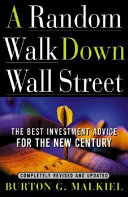

The Efficient Market Hypothesis (EMH) posits that asset prices reflect all available information. This means that it is impossible to consistently achieve higher returns than average market returns on a risk-adjusted basis, as any new information is quickly and accurately incorporated into stock prices. The book discusses the implications of EMH for investors, suggesting that trying to outperform the market through stock picking or market timing is largely futile. Instead, it advocates for a passive investment strategy, such as index funds, which can capture the overall market return without the associated risks of active trading.
Continue readingThe Random Walk Theory suggests that stock price movements are unpredictable and follow a random path. This theory implies that past price movements cannot be used to predict future price movements, making it difficult for investors to forecast stock performance. The author emphasizes that even expert analysts and fund managers cannot consistently beat the market due to this randomness. This leads to the conclusion that a long-term investment strategy, focusing on a diversified portfolio, is more effective than attempting to time the market based on short-term price fluctuations.
Continue readingBehavioral finance examines how psychological factors influence investors' decisions and market outcomes. The book highlights various cognitive biases that can lead to irrational behavior, such as overconfidence, loss aversion, and herding behavior. These biases can cause investors to make poor decisions, such as holding onto losing investments or chasing trends. Understanding these psychological influences can help investors make more rational choices and avoid common pitfalls in investing, ultimately leading to better financial outcomes.
Continue readingThe book outlines several investment strategies, including fundamental analysis, technical analysis, and the use of modern portfolio theory. Fundamental analysis involves evaluating a company's financial health and market position, while technical analysis focuses on price patterns and trends. The author critiques these methods, arguing that they often fail to provide a reliable edge in the market. Instead, the book promotes a diversified, long-term investment approach that minimizes risks and maximizes returns through asset allocation and rebalancing.
Continue readingDiversification is a key principle in investing, as it helps to spread risk across various assets and reduce the impact of poor performance from any single investment. The book emphasizes the importance of constructing a diversified portfolio that includes a mix of asset classes, such as stocks, bonds, and real estate. By doing so, investors can achieve a more stable return over time and protect themselves against market volatility. The author also discusses the concept of risk tolerance and how it should guide the diversification strategy for individual investors.
Continue readingThe book examines the role of financial advisors in the investment process, highlighting the potential benefits and pitfalls of seeking professional guidance. While a good advisor can provide valuable insights and help investors develop a sound strategy, the author warns that not all advisors have the same level of expertise or ethical standards. Investors should be cautious when selecting an advisor and ensure they are aligned with their financial goals and risk tolerance. Ultimately, the book suggests that self-education and a solid understanding of investment principles can empower investors to make informed decisions.
Continue readingThe book advocates for a long-term investment mindset, encouraging investors to focus on their financial goals rather than short-term market fluctuations. By adopting a patient approach and resisting the temptation to react to daily market news, investors can better position themselves for long-term success. The author emphasizes the importance of staying committed to a well-thought-out investment strategy, even during periods of market turbulence. This perspective can help investors avoid emotional decision-making and achieve their financial objectives over time.
Continue reading